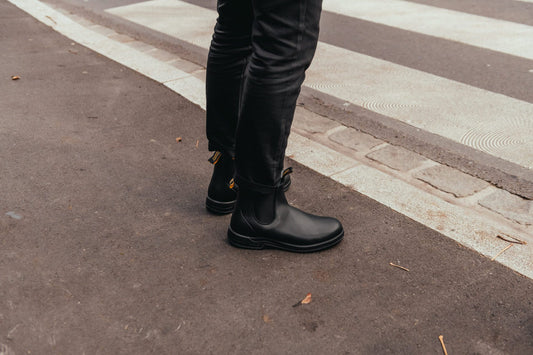Finally! After a long boat trip of 93 days from England, John Blundstone and his sons reach the mainland. A new beginning. They arrive in the port city of Hobart, the capital of the Australian island of Tasmania. After a few years, the Blundstone family has explored all the hotspots of the island and has fully integrated into the culture. John Blundstone can't sit still and is tired of working at the local supermarket. It's time for him to do something.
The start of Blundstone
So John starts importing boots from England. Sales of these boots are going so well that John decides to make his own boots from locally produced leather. The boots that John makes from locally produced leather are also flying out the door. His hobby is starting to become a lot more serious. John's hobby is such a success that in 1870 he starts his own company called Blundstone. John is building his own shoe factory in the ultra-modern center of Hobart. This shoe factory can produce 2000 pairs of boots and shoes per week.
The turning point
A few years after the pleasant life in Australia, the atmosphere changes. There are tensions between different countries around the world. A terrible period begins. The first World War. Fortunately, there is still a bright spot for the Blundstones in this war to keep their company afloat to some extent. Blundstone is chosen as one of 20 manufacturers contracted to make boots and shoes for the Australian military.
Blundstone takeover
Ultimately, John's company is not doing so well after the war. In order to keep the company going and continue selling good quality boots, Blundstone is taken over by the English Cuthbertson family. The Cuthbertson family already has a tannery in Hobart. When taking over Blundstone, the Cuthbertsons decided to keep the Blundstone name for the company, because Blundstone is associated with quality and reliability.
A few years later, tensions rise again between various countries in the world, leading to the Second World War. Blundstone is also lucky in this world war and they are allowed to produce half a million boots for the Australian army. During the war, the American soldiers saw the Blundstone boots on the Australian soldiers. The Americans are very curious about these boots and try with varying degrees of success to exchange their own boots with the boots of the Australian soldiers.
Successes after the war
After the war, Blundstone led the way with its advanced sole technology, design and ingenuity. This quickly spreads among the brand's potential customers. Many requests soon came in. Customers want boots made to order that can withstand the most extreme conditions. The factory is flooded with orders. By the late 1950s, Blundstone was producing up to 200 pairs of boots per day.
Award-winning #500 boots
In the 1960s, Blundstone was even the largest shoe manufacturer in Tasmania. Because the company is doing so well, the Cuthbertsons decide to launch a new series of shoes. This is how the #500 boots series was born. These are still the well-known Chelsea boots, but with a sole designed with new technologies. The new range of Chelsea boots has been loved by workers, adventurers and creatives. In fact, the #500 boots were so popular that more than 25 million pairs were sold worldwide! The Australian government even became aware of the popularity of the boots and entered into a partnership with Blundstone through their company CSIRO. In the late 1970s, the shoe manufacturer Blundstone became the lucky winner of the Australian Design Award.
The growth of the brand and blundstone in bloom
After the many successes achieved after the war, it is time to expand. The current factory will move to another village in Tasmania and a new factory will be established in New Zealand. Not only is production capacity growing, the product range is growing along with it. Rubber boots are added to the range and they start extensive exports to Europe.
Collaborations
Blundstone has partnered with Sydney Dance Company's Tap Dogs production, expanding its range even further with boots for children, safety shoes for women and a range of lace-up shoes. Production of all these new products has been going so well that up to a million pairs of boots have been produced annually at the Hobart factory since the mid-2000s.
Meanwhile, the company continues to evolve and changes are made to its global supply chain and trade agreements. With this, Blundstone is taking a new direction. The production of the leather is expanding internationally and the products are produced in six locations around the world. International fame continues to grow. To advertise, Australian athletes proudly wore Blundstone thermal boots during the 2014 Winter Olympics. A year later, the Australian Design Award was won with the #980 mining boot.
Today, Blundstone boots are worn all over the world and are loved by young and old, for work and play. To this day, Blundstone remains a proud family business with its headquarters in Tasmania.
Would you like to read more about Blundstone ? Then read the blog about Blundstone.


